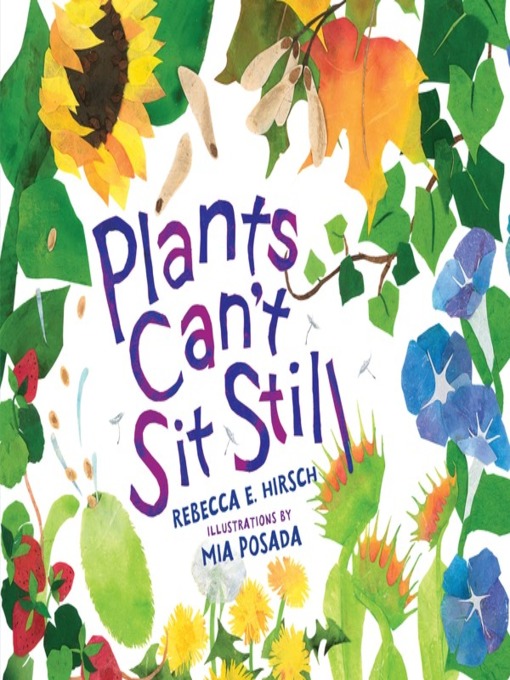-
Creators
-
Publisher
-
Release date
August 1, 2016 -
Formats
-
OverDrive Read
- ISBN: 9781512420449
-
PDF ebook
- ISBN: 9781512411096
- File size: 8677 KB
-
-
Languages
- English
-
Levels
- Lexile® Measure: 510
- Text Difficulty: 1-2
-
Reviews
-
School Library Journal
July 1, 2016
K-Gr 3-Focusing on an aspect of plant life that not many consider, this title examines the ways in which plants move: sunflowers turning toward the sun, a snapping Venus flytrap, and seeds hitching a ride downriver. Hirsch uses simple verbs (e.g., wiggle, reach, unfold) to explore a characteristic or trait of plants (specifically their need to seek out "water, sunshine, and room to grow"), leading up to the refrain "plants can't sit still." Each verb is given a different color from the main text, adding the benefit of text awareness and vocabulary to the title. Illustrator Posada artfully uses cut-paper collage and watercolor to depict, for instance, roots searching underground for water, flowers growing upward on a trellis, winged seeds gliding in the air, and tulips closing up at night. Back matter identifies and provides further information on the flora found throughout. VERDICT The bright illustrations and the simple but moving text make this a solid addition to any collection looking to inspire interest in the natural world.-Laura Stanfield, Campbell County Public Library, Fort Thomas, KY
Copyright 2016 School Library Journal, LLC Used with permission.
-
Kirkus
Starred review from June 1, 2016
Double-page spreads of watercolor and collage use minimal words to describe how and why plants move."Plants don't have feet or fins or wings, yet they can move in many ways. / Look closely and you'll discover that plants can't sit still." These words dance across two pages loaded with images of several kinds of plants in different stages of their lives: seeds, vines, flowers, fruits. Colorful, exuberant illustrations work impressively with the text to prove that plants--in every stage--move in order to find and acquire uniform needs: "water, sunshine, and room to grow." Throughout, readers are treated to a plethora of words more often used for fauna than flora, such as "wiggle" and "squirm." Nighttime images show bean leaves "nodding" and tulip flowers "folding," while moon flowers "wake with the stars." One sentence is momentarily startling to adults with fixed definitions: "A seed is a plant built for travel." However, the pages that follow easily support that statement, as different kinds of seeds depart from parent plants, travel, and grow into seedlings. The resources at the end of the book are as well-planned and carefully executed as the rest, offering information--including names and descriptions of every plant in the book--that expands the interest level of the text from preschool into early elementary. Excellent collaboration produced a winner: graceful, informative, and entertaining. (Informational picture book. 3-8)COPYRIGHT(2016) Kirkus Reviews, ALL RIGHTS RESERVED.
-
Booklist
Starred review from July 1, 2016
Grades K-3 *Starred Review* In comparison to animals, plants seem rooted in one place, but that doesn't mean they're not in motion. Underground, their roots slither along, searching for water and sometimes sending up new shoots. Seedlings push through the soil, unfurl their leaves, and grow toward the sun. Some leaves shrink when they sense vibrations, while others snap shut to catch a fly. Seeds can be long-distance travelers, from small, light ones that whirl and glide through the air, to a large one that floats across oceans. With a doctorate in biology, Hirsch understands her subject, but equally important is her ability to communicate with well-chosen words that make the ideas fun and memorable for children. While some may be content with the main text alone, others will be fascinated by appended descriptions of a squirting cucumber shooting its seeds, or a raspberry seed riding through a bear's digestive system. Posada's impressive artwork, created with cut-paper collage and watercolors, illustrates the ideas clearly while creating varied, often lovely effects with colors and textures. Back matter fully supports the picture-book text with additional information on each of the plants featured, but not named, in the main section. A new way to see the plants around us.(Reprinted with permission of Booklist, copyright 2016, American Library Association.) -
The Horn Book
July 1, 2017
Gorgeous cut-paper collages with watercolor illustrate this poetic celebration of plant tropisms. A spare, repetitive text explains how and why plants move--"searching for the things that all plants need: water, sunshine, and room to grow." The "More About Plants" appendix offers facts about each plant depicted; an author's note mentions Hirsch's sources and inspiration. Reading list, websites. Glos.(Copyright 2017 by The Horn Book, Incorporated, Boston. All rights reserved.)
-
Formats
- OverDrive Read
- PDF ebook
Languages
- English
Levels
- Lexile® Measure:510
- Text Difficulty:1-2
Loading
Why is availability limited?
×Availability can change throughout the month based on the library's budget. You can still place a hold on the title, and your hold will be automatically filled as soon as the title is available again.
The Kindle Book format for this title is not supported on:
×Read-along ebook
×The OverDrive Read format of this ebook has professional narration that plays while you read in your browser. Learn more here.




